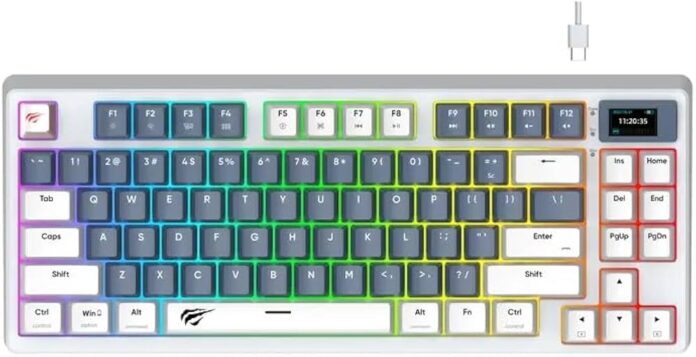Keyboards are an essential input device for both work and play. Whether you’re a competitive gamer, a writer, or simply browsing the internet, the right keyboard can significantly enhance your experience.
Key Factors to Consider:
- Type:
- Membrane: Budget-friendly, quiet, but offer limited tactile feedback.
- Mechanical: Known for durability, responsiveness, and distinct feel. Offer various switch types (clicky, linear, tactile) with varying levels of noise and feedback.
- Low-profile Mechanical: Offer the advantages of mechanical switches while maintaining a slimmer profile.
- Optical: Utilize light beams for actuation, offering fast response times and consistent performance.
- Switch Type (for Mechanical Keyboards):
- Clicky: Loudest, provide audible and tactile feedback (e.g., Cherry MX Blue, Logitech Gateron Blue).
- Linear: Smooth and consistent keystrokes with no tactile bump (e.g., Cherry MX Red, Speed Silver).
- Tactile: Offer a noticeable bump without a loud click (e.g., Cherry MX Brown, Kailh Box Brown).
- Layout:
- Full-size: Includes a number pad, ideal for data entry and work.
- TKL (Tenkeyless): Lacks the number pad, saving desk space.
- 60%: Compact, lacks function keys and number pad, maximizing portability.
- 75%: Offers a good balance between size and functionality.
- Connectivity:
- Wired: Generally more reliable and offers lower latency.
- Wireless: Provides flexibility and eliminates cable clutter.
- Backlighting:
- RGB: Offers customizable lighting effects and zones for personalization.
- Single-color: Provides basic illumination for low-light conditions.
- Ergonomics:
- Split keyboards: Allow for a more natural hand position.
- Wrist rests: Provide support and reduce strain.
- Adjustable tilt: Allows for personalized comfort.
Popular Keyboard Brands and Models:
- Gaming:
- Corsair: K70 RGB TKL, K95 RGB Platinum XT
- Logitech Keyboard: G Pro X, G915 TKL
- Razer keyboard: BlackWidow V3, Huntsman V2
- SteelSeries: Apex Pro, Apex 7 TKL
- Redragon Keyboard -etc
- Everyday Use:
- Keychron: K2, K8
- Anne Pro 2: Compact and customizable
- Leopold: FC660C, FC750R
- Ducky: One 2 SF, Shine 7
Keyboards for Specific Needs:
- Programmers:
- Keychron K2: Budget-friendly, hot-swappable, and comes in various sizes.
- Leopold FC660C: Compact and minimalist, known for its excellent build quality.
- Das Keyboard 4 Professional: Focuses on functionality with a clean design and Cherry MX Brown switches.
- Creative Professionals (Designers, Artists):
- Logitech MX Keys: Sleek and minimalist with excellent ergonomics and multi-device connectivity.
- Apple Magic Keyboard: Seamlessly integrates with Apple devices and offers a comfortable typing experience.
- Microsoft Sculpt Ergonomic Keyboard: Unique split design promotes a more natural hand position.
- Office Workers:
- Microsoft Surface Keyboard: Slim and portable, perfect for on-the-go professionals.
- Logitech Craft: Features a unique Crown dial for precise control in creative applications.
- Kinesis Freestyle2 Blue: Highly adjustable and ergonomic, ideal for long typing sessions.
Advanced Features:
- Hot-swappable switches: Allows for easy customization and experimentation with different switch types.
- Macro keys: Programmable keys for executing complex commands with a single keystroke.
- On-board memory: Stores custom profiles and settings directly on the keyboard.
- Wireless charging: Convenient for wireless keyboards, eliminating the need for frequent battery replacements.
Tips for Maintaining Your Keyboard:
- Regular cleaning: Use compressed air or a soft brush to remove dust and debris.
- Avoid spills: Keep drinks away from your keyboard.
- Use a keyboard cover: Protect your keyboard from dust and scratches when not in use.
Additional Considerations:
- Personal preferences: Ultimately, the best keyboard for you will depend on your individual needs, preferences, and budget.
- Try before you buy: If possible, visit a local store or try out different keyboards at a friend’s house to get a feel for them.
- Read reviews: Consult online reviews and comparisons to gather information and insights from other users.
Tips for Choosing:
- Determine your budget: Prices can vary significantly.
- Consider your needs: Gaming, work, typing, etc.
- Read reviews: See what other users have to say.
- Try before you buy: If possible, test different keyboards in person.
Conclusion:
Selecting the right keyboard is a personal choice. By carefully considering your needs and preferences, you can find a keyboard that enhances your productivity and enjoyment.


